2006 KIA AMANTI service
[x] Cancel search: servicePage 2 of 322

iThank you for choosing a Kia vehicle.
When you require service, remember that your dealer
knows your vehicle best. Your dealer has factory-trained
technicians, recommended special tools, genuine Kia
replacement parts and is dedicated to your complete sat-
isfaction.
Because subsequent owners require this important infor-
mation as well, this publication should remain with the
vehicle if it is sold.
This manual will familiarize you with operational, main-
tenance and safety information about your new vehicle. It
is supplemented by a Warranty and Consumer
Information manual that provides important information
on all warranties regarding your vehicle. If your vehicle
is equipped with an audio system, you will also have a
Kia Integrated Audio System manual explaining its oper-
ation. We urge you to read these publications carefully
and follow the recommendations to help assure enjoyable
and safe operation of your new vehicle.
Kia offers a great variety of options, components and fea-
tures for its various models.
Therefore, the equipment described in this manual, along
with the various illustrations, may not all be applicable to
your particular vehicle. The information and specifications provided in this man-
ual were accurate at the time of printing. Kia reserves the
right to discontinue or change specifications or design at
any time without notice and without incurring any obli-
gation. If you have questions, always check with your
Kia Dealer.
We assure you of our continuing interest in your motor-
ing pleasure and satisfaction in your Kia vehicle.
© 2005 Kia Motors America, Inc.
All rights reserved. May not be reproduced or translated
in whole or in part without the written consent of Kia
Motors America, Inc.
Printed in KoreaForeword
Page 19 of 322
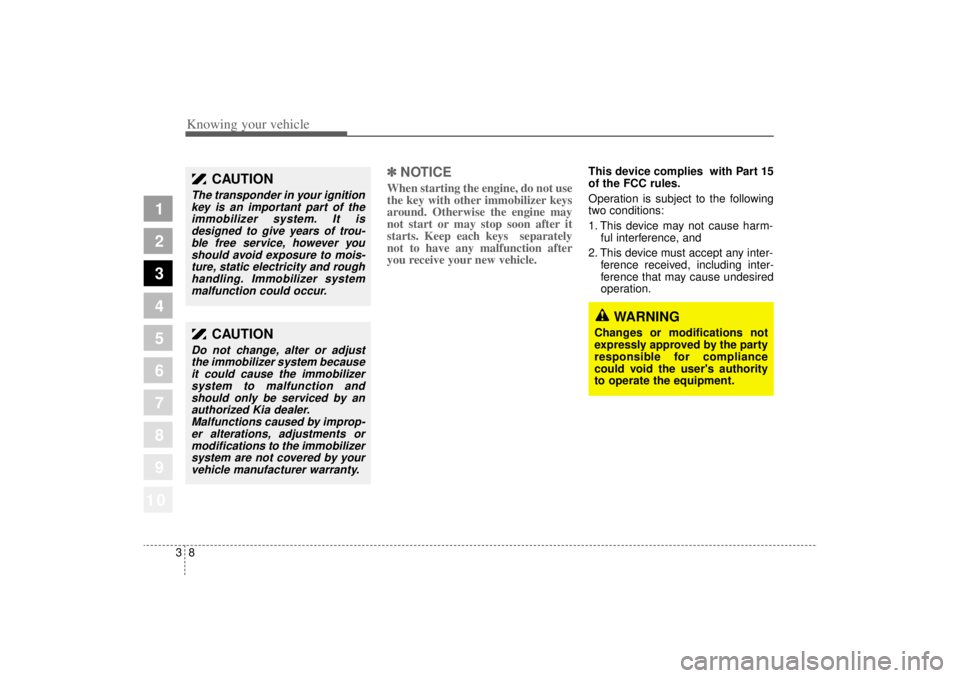
Knowing your vehicle83
1
2
3
4
5
6
7
8
910
✽ ✽NOTICEWhen starting the engine, do not use
the key with other immobilizer keys
around. Otherwise the engine may
not start or may stop soon after it
starts. Keep each keys separately
not to have any malfunction after
you receive your new vehicle.
This device complies with Part 15
of the FCC rules.
Operation is subject to the following
two conditions:
1. This device may not cause harm-
ful interference, and
2. This device must accept any inter- ference received, including inter-
ference that may cause undesired
operation.
CAUTION
The transponder in your ignitionkey is an important part of theimmobilizer system. It isdesigned to give years of trou-ble free service, however youshould avoid exposure to mois-ture, static electricity and roughhandling. Immobilizer systemmalfunction could occur.
CAUTION
Do not change, alter or adjustthe immobilizer system becauseit could cause the immobilizersystem to malfunction andshould only be serviced by anauthorized Kia dealer.Malfunctions caused by improp-er alterations, adjustments ormodifications to the immobilizersystem are not covered by yourvehicle manufacturer warranty.
WARNING
Changes or modifications not
expressly approved by the party
responsible for compliance
could void the user's authority
to operate the equipment.
Page 49 of 322
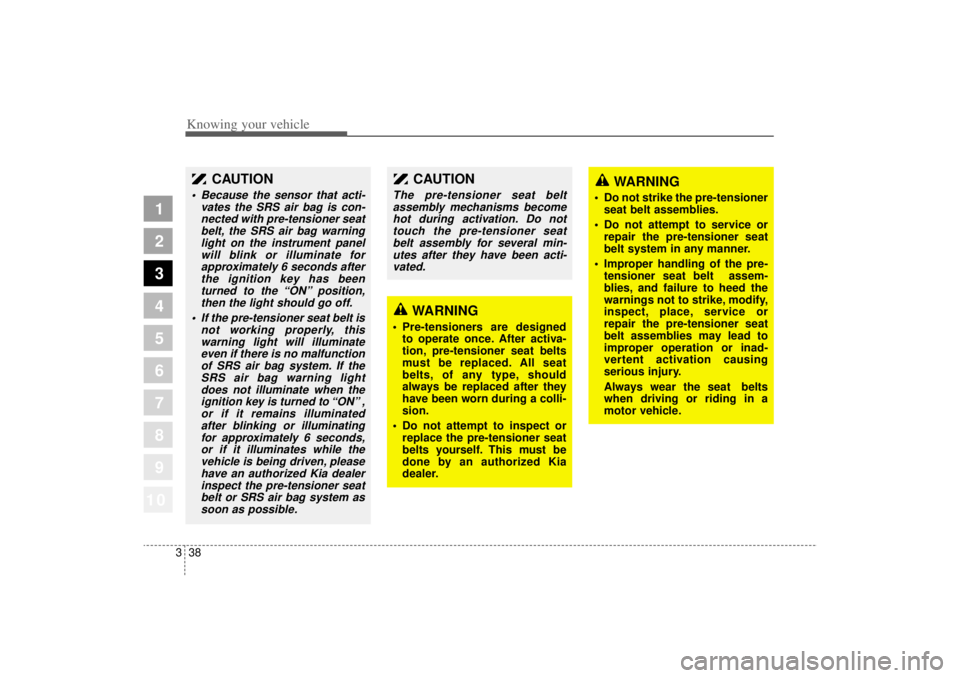
Knowing your vehicle38
3
1
2
3
4
5
6
7
8
910
WARNING
Do not strike the pre-tensioner
seat belt assemblies.
Do not attempt to service or
repair the pre-tensioner seat
belt system in any manner.
Improper handling of the pre-
tensioner seat belt assem-
blies, and failure to heed the
warnings not to strike, modify,
inspect, place, service or
repair the pre-tensioner seat
belt assemblies may lead to
improper operation or inad-
vertent activation causing
serious injury.
Always wear the seat belts
when driving or riding in a
motor vehicle.
CAUTION
Because the sensor that acti-
vates the SRS air bag is con-nected with pre-tensioner seatbelt, the SRS air bag warninglight on the instrument panelwill blink or illuminate forapproximately 6 seconds afterthe ignition key has beenturned to the “ON”position,
then the light should go off.
If the pre-tensioner seat belt is
not working properly, thiswarning light will illuminateeven if there is no malfunctionof SRS air bag system. If theSRS air bag warning lightdoes not illuminate when theignition key is turned to “ON”,
or if it remains illuminated after blinking or illuminatingfor approximately 6 seconds,or if it illuminates while thevehicle is being driven, pleasehave an authorized Kia dealerinspect the pre-tensioner seatbelt or SRS air bag system assoon as possible.
WARNING
Pre-tensioners are designed
to operate once. After activa-
tion, pre-tensioner seat belts
must be replaced. All seat
belts, of any type, should
always be replaced after they
have been worn during a colli-
sion.
Do not attempt to inspect or
replace the pre-tensioner seat
belts yourself. This must be
done by an authorized Kia
dealer.
CAUTION
The pre-tensioner seat belt
assembly mechanisms becomehot during activation. Do nottouch the pre-tensioner seatbelt assembly for several min-utes after they have been acti-vated.
Page 72 of 322
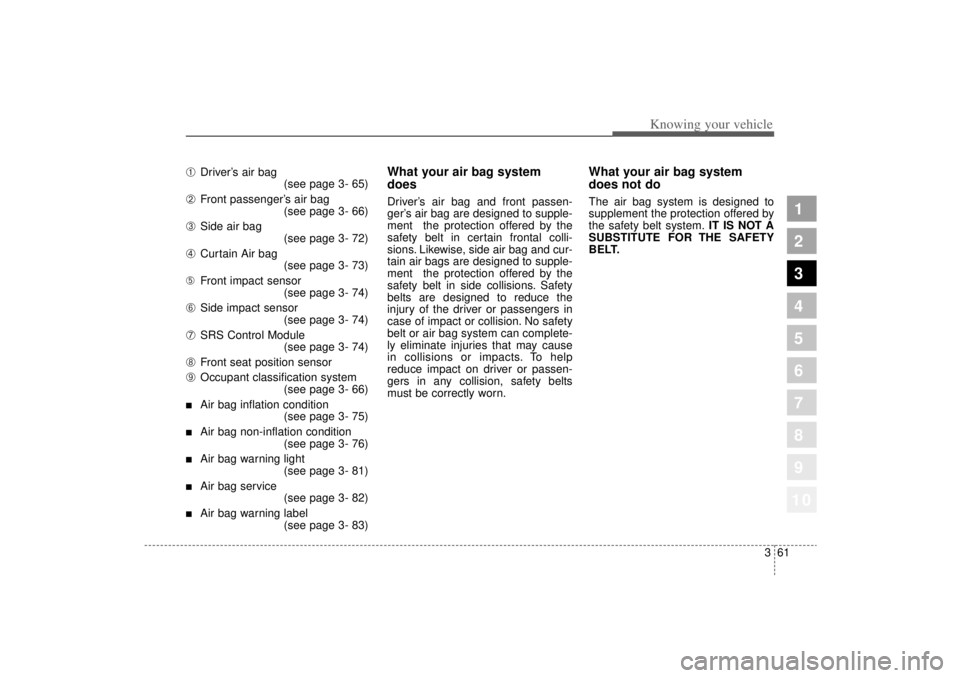
361
1
2
3
4
5
6
7
8
910
Knowing your vehicle
➀
Driver’s air bag
(see page 3- 65)
➁
Front passenger’ s air bag
(see page 3- 66)
➂
Side air bag (see page 3- 72)
➃
Curtain Air bag(see page 3- 73)
➄ Front impact sensor
(see page 3- 74)
\b
Side impact sensor(see page 3- 74)
➆
SRS Control Module(see page 3- 74)
➇
Front seat position sensor
\f
Occupant classification system(see page 3- 66)
Air bag inflation condition(see page 3- 75)
Air bag non-inflation condition(see page 3- 76)
Air bag warning light(see page 3- 81)
Air bag service(see page 3- 82)
Air bag warning label(see page 3- 83)
What your air bag system
doesDriver’s air bag and front passen-
ger’ s air bag are designed to supple-
ment the protection offered by the
safety belt in certain frontal colli-
sions. Likewise, side air bag and cur-
tain air bags are designed to supple-
ment the protection offered by the
safety belt in side collisions. Safety
belts are designed to reduce the
injury of the driver or passengers in
case of impact or collision. No safety
belt or air bag system can complete-
ly eliminate injuries that may cause
in collisions or impacts. To help
reduce impact on driver or passen-
gers in any collision, safety belts
must be correctly worn.
What your air bag system
does not doThe air bag system is designed to
supplement the protection offered by
the safety belt system. IT IS NOT A
SUBSTITUTE FOR THE SAFETY
BELT.
Page 93 of 322
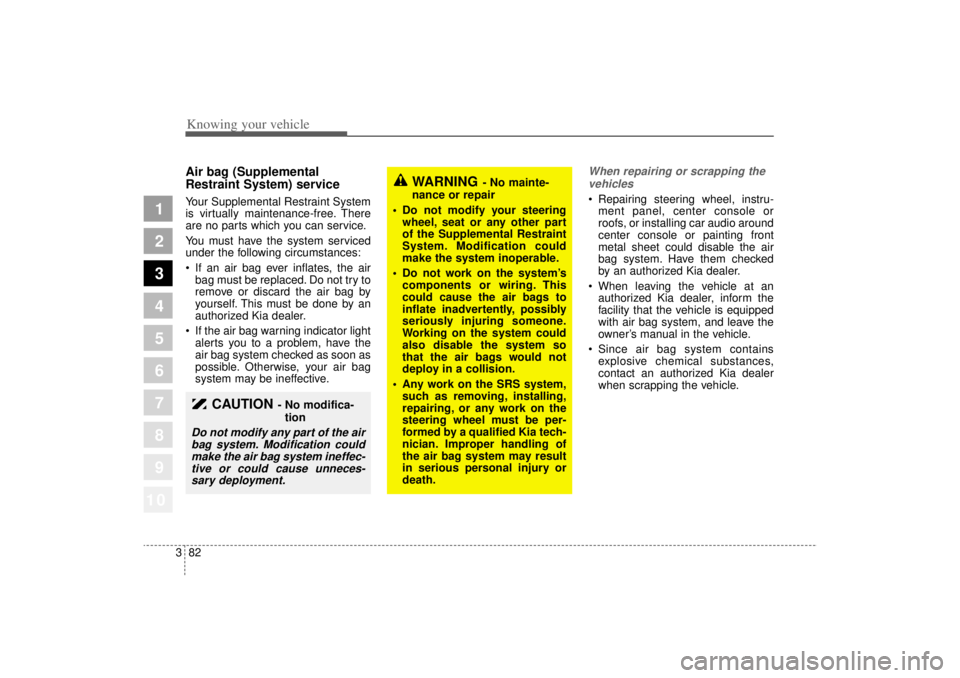
Knowing your vehicle82
3
1
2
3
4
5
6
7
8
910
Air bag (Supplemental
Restraint System) service Your Supplemental Restraint System
is virtually maintenance-free. There
are no parts which you can service.
You must have the system serviced
under the following circumstances:
If an air bag ever inflates, the air
bag must be replaced. Do not try to
remove or discard the air bag by
yourself. This must be done by an
authorized Kia dealer.
If the air bag warning indicator light
alerts you to a problem, have the
air bag system checked as soon as
possible. Otherwise, your air bag
system may be ineffective.
When repairing or scrapping the
vehicles Repairing steering wheel, instru-
ment panel, center console or
roofs, or installing car audio around
center console or painting front
metal sheet could disable the air
bag system. Have them checked
by an authorized Kia dealer.
When leaving the vehicle at an
authorized Kia dealer, inform the
facility that the vehicle is equipped
with air bag system, and leave the
owner’ s manual in the vehicle.
Since air bag system contains
explosive chemical substances,
contact an authorized Kia dealer
when scrapping the vehicle.
WARNING
- No mainte-
nance or repair
Do not modify your steering
wheel, seat or any other part
of the Supplemental Restraint
System. Modification could
make the system inoperable.
Do not work on the system ’s
components or wiring. This
could cause the air bags to
inflate inadvertently, possibly
seriously injuring someone.
Working on the system could
also disable the system so
that the air bags would not
deploy in a collision.
Any work on the SRS system,
such as removing, installing,
repairing, or any work on the
steering wheel must be per-
formed by a qualified Kia tech-
nician. Improper handling of
the air bag system may result
in serious personal injury or
death.
CAUTION
- No modifica-
tion
Do not modify any part of the airbag system. Modification couldmake the air bag system ineffec-tive or could cause unneces-sary deployment.
Page 128 of 322
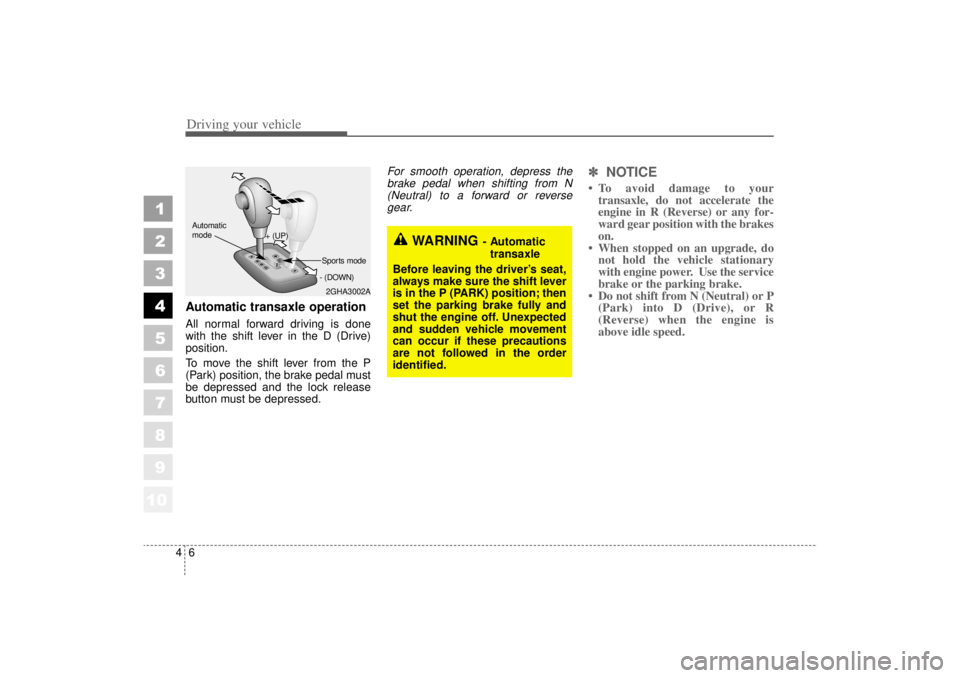
Driving your vehicle64
1
2
3
4
5
6
7
8
910
Automatic transaxle operationAll normal forward driving is done
with the shift lever in the D (Drive)
position.
To move the shift lever from the P
(Park) position, the brake pedal must
be depressed and the lock release
button must be depressed.
For smooth operation, depress thebrake pedal when shifting from N(Neutral) to a forward or reversegear.
✽ ✽
NOTICE• To avoid damage to your
transaxle, do not accelerate the
engine in R (Reverse) or any for-
ward gear position with the brakes
on.
• When stopped on an upgrade, do not hold the vehicle stationary
with engine power. Use the service
brake or the parking brake.
• Do not shift from N (Neutral) or P (Park) into D (Drive), or R
(Reverse) when the engine is
above idle speed.
2GHA3002A
+ (UP)
- (DOWN)
Automatic
modeSports mode
WARNING
- Automatic
transaxle
Before leaving the driver’s seat,
always make sure the shift lever
is in the P (PARK) position; then
set the parking brake fully and
shut the engine off. Unexpected
and sudden vehicle movement
can occur if these precautions
are not followed in the order
identified.
Page 130 of 322
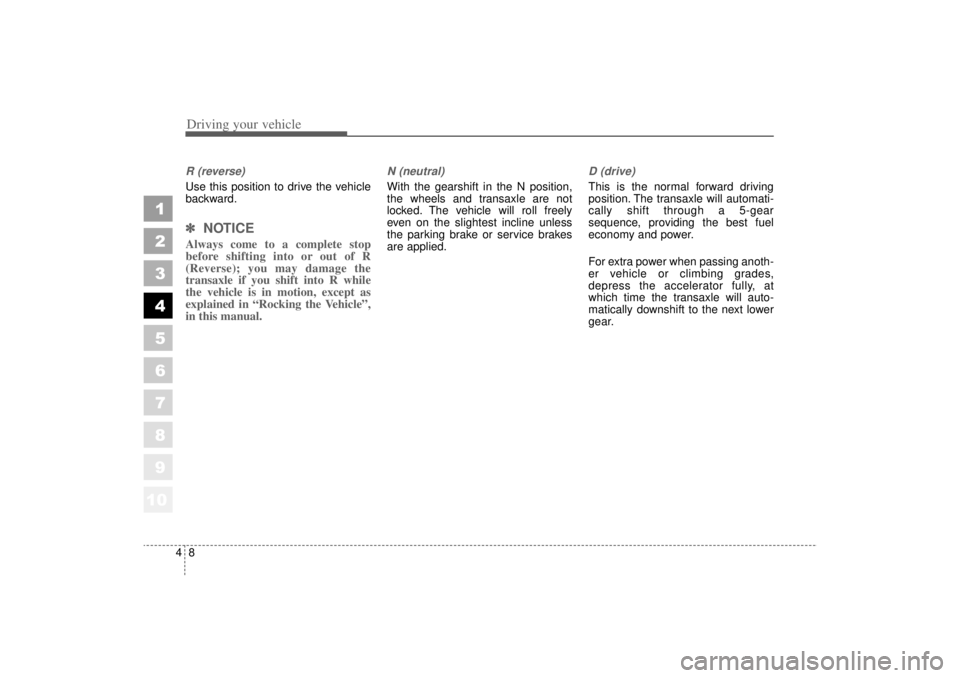
Driving your vehicle84
1
2
3
4
5
6
7
8
910
R (reverse)Use this position to drive the vehicle
backward.✽ ✽
NOTICEAlways come to a complete stop
before shifting into or out of R
(Reverse); you may damage the
transaxle if you shift into R while
the vehicle is in motion, except as
explained in “Rocking the Vehicle”,
in this manual.
N (neutral)With the gearshift in the N position,
the wheels and transaxle are not
locked. The vehicle will roll freely
even on the slightest incline unless
the parking brake or service brakes
are applied.
D (drive)This is the normal forward driving
position. The transaxle will automati-
cally shift through a 5-gear
sequence, providing the best fuel
economy and power.
For extra power when passing anoth-
er vehicle or climbing grades,
depress the accelerator fully, at
which time the transaxle will auto-
matically downshift to the next lower
gear.
Page 132 of 322

Driving your vehicle10
4
1
2
3
4
5
6
7
8
910
Moving up a steep grade from
a standing startTo move up a steep grade from a
standing start, depress the brake
pedal, shift the shift lever to D
(Drive). Select the appropriate gear
depending on load weight and steep-
ness of the grade, and release the
parking brake. Depress the accelera-
tor gradually while releasing the
service brakes.
When accelerating from a stop on
a steep hill, the vehicle may have a
tendency to roll backwards.
Shifting the shift lever into 2
(Second Gear) while in Sport
mode will help prevent the vehi-
cle from rolling backwards.
Shift lock systemFor your safety, the Automatic
Transaxle has a shift lock system
which prevents shifting the transaxle
out of P (Park) unless the brake
pedal is depressed.
To shift the transaxle out of P (Park):
1. Depress and hold the brake pedal.
2. Start the engine or turn the ignition
to the ON position.
3. Depress the lock release button and move the shift lever.
If the brake pedal is repeatedly
depressed and released with the
shift lever in the P (Park) position, a
chattering sound near the shift lever
may be heard. This is a normal con-
dition.
Ignition key inter lock systemThe ignition key cannot be removed
unless the shift lever is in the P
(Park) position. If the ignition switch
is in any other position, the key can-
not be removed.